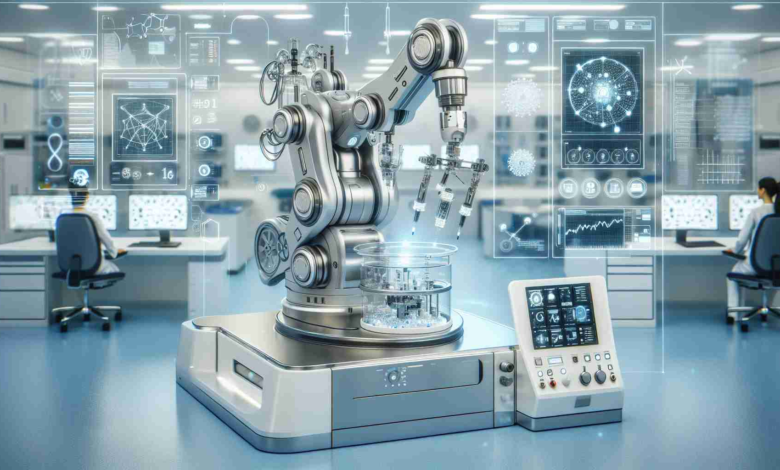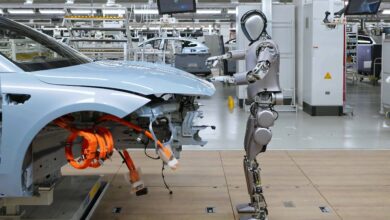Innovative Robotic System Revolutionizes Chemotherapy Preparation

Summary: The introduction of a robotic system for chemotherapy drug preparation at Trinity St James’s Cancer Institute marks a significant technological advance in patient treatment and safety. This cutting-edge robot enhances efficiency and reduces the risks associated with manual drug compounding. New market research predicts a surge in medical robotic technologies, which suggests a promising future for healthcare innovation.
The healthcare sector is embracing a pivotal technological transition with robotics becoming increasingly vital in patient care. At the forefront of this evolution, Trinity St James’s Cancer Institute at St James’s Hospital has employed a robotic system to prepare chemotherapy drugs, a move that enhances patient safety and addresses the growing demand for cancer care services.
The transition to robotic technology for intricate medical procedures such as chemotherapy preparation exemplifies the bold steps being taken to improve healthcare efficiency. The state-of-the-art compounding robot now operational at St James’s Hospital contributes to the meticulous production of chemotherapy treatments, offering high precision and speed. This ensures more reliable and timely delivery of care to patients, alleviating pressures on the pharmacy staff and redirecting their expertise to other essential patient services.
This innovative approach not only constitutes a leap in patient-centered care but also illustrates the ongoing transformations in the medical industry aimed at bolstering treatment efficacy. For instance, cancer patient Liz Hogan’s treatment remained unchanged with the introduction of the robotic system, demonstrating seamless integration into clinical practice.
The global healthcare market forecasts immense growth in medical robotics, propelled by technological advancements, increased healthcare spending, and a rise in chronic illnesses. Even as the industry navigates obstacles like the cost and training associated with robotic systems, the overarching trend points towards more widespread adoption and ongoing research to optimize such technologies.
For further information on healthcare advancements and industry trends, resources like the World Health Organization (WHO) and the National Health Service (NHS) provide extensive data and analysis.
In conclusion, the integration of robotics in healthcare settings, as illustrated by the innovative use at St James’s Hospital, indicates an exciting era of technology-enhanced medical care. With robust market growth anticipated for medical robotics, the healthcare field is on the verge of significant change that holds great promise for both patients and healthcare professionals.
The Integration of Robotics in Healthcare
The healthcare industry is currently in the midst of a significant technological shift, with robotics playing an increasingly crucial role. The implementation of a robotic drug compounding system at Trinity St James’s Cancer Institute sets a new precedent in the healthcare sector—especially in the preparation of chemotherapy drugs. This advancement promises to revolutionize patient care by improving safety and efficiency in treatment delivery.
Robotic systems such as the one at St James’s Hospital are becoming more prevalent in hospitals worldwide. They are designed to handle tasks that are typically repetitive, require high precision, or pose safety risks to human workers, such as exposure to toxic chemotherapy agents. Such technological adoption aligns perfectly with the industry’s move toward precision medicine and patient safety.
The utilization of advanced robotics in drug compounding is a clear example of how technology can improve the accuracy of medication dosing, reduce contamination risks, and enable pharmacy staff to focus on more critical patient-centric roles.
Market Forecasts and Expansion of Medical Robotics
Market analysis suggests a substantial increase in investment and growth in the medical robotics sector. Factors such as aging populations, increased prevalence of chronic diseases, technological innovation, and rising healthcare expenditure are key drivers behind this surge. As medical facilities seek to provide better care and improve outcomes, the adoption of robotic systems is likely to escalate.
Despite the potential benefits, several challenges persist in fully integrating robotic technologies in healthcare settings. These challenges include steep initial costs, ongoing maintenance expenses, the need for staff training, and ensuring interoperability with existing health IT systems. Nevertheless, the expected efficiencies and improvements in patient care are driving forces behind the industry’s rapid adoption of robotics.
For those interested in the broader implications and future of healthcare innovations, reliable information can be sourced from organizations such as the World Health Organization (WHO) and the National Health Service (NHS). These provide valuable insights into healthcare trends, policies, and technology adoption.
In summary, the introduction of medical robotics into healthcare settings signals a new frontier in patient care. The use of these technologies in institutions like St James’s Hospital showcases how healthcare providers are harnessing innovation to improve efficiency, patient safety, and care quality. With market forecasts predicting robust growth, the healthcare industry is poised for transformative changes that have the potential to significantly enhance the quality of care provided to patients worldwide.

Leokadia Głogulska is an emerging figure in the field of environmental technology, known for her groundbreaking work in developing sustainable urban infrastructure solutions. Her research focuses on integrating green technologies in urban planning, aiming to reduce environmental impact while enhancing livability in cities. Głogulska’s innovative approaches to renewable energy usage, waste management, and eco-friendly transportation systems have garnered attention for their practicality and effectiveness. Her contributions are increasingly influential in shaping policies and practices towards more sustainable and resilient urban environments.



